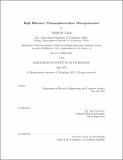High efficiency thermophotovoltaic microgenerators
Author(s)
Chan, Walker R
DownloadFull printable version (8.001Mb)
Other Contributors
Massachusetts Institute of Technology. Department of Electrical Engineering and Computer Science.
Advisor
Ivan Celanovic.
Terms of use
Metadata
Show full item recordAbstract
We proposed, designed, and demonstrated a first-of-a-kind millimeter-scale thermophotovoltaic (TPV) system using a metallic microburner, photonic crystal (PhC) emitter, and low bandgap TPV cells. Many technologies (fuel cells, Stirling, thermoelectric, etc.) that potentially enable a portable millimeter-scale hydrocarbon microgenerator are under active investigation because conventional fuels offer energy densities fifty times that of batteries. In a TPV system, combustion heats an emitter to incandescence and the resulting thermal radiation is converted to electricity by photovoltaic cells. Our approach uses a moderate temperature (1000{1200°C) microburner coupled to a high emissivity, high selectivity PhC selective emitter and low bandgap TPV cells. The PhC emitter and low bandgap cells minimize total microgenerator mass by enabling simultaneous high eciency and high power density, even at moderate temperatures which allow ecient coupling to the combustion process by reducing undesired heat loss mechanisms. This approach is predicted to be capable of up to 30% ecient fuel-to-electricity conversion within a millimeter-scale form factor. Although considerable technological barriers need to be overcome to reach full performance, we have performed a robust experimental demonstration that validates the theoretical framework and the key system components. We first demonstrated a first-of-a-kind TPV system built from a 1010 mm catalytic silicon MEMS microburner with a Si/SiO₂ 1D PhC matched to the InGaAsSb (Eg = 0:55 eV) cells which achieved 2.7% fuel-to-electricity eciency, a millimeter-scale record, at a power of 344 mWe. We then proposed, designed, and demonstrated a highly robust metallic platform comprised of a 2020 mm Inconel microburner and a higher performance 2D tantalum PhC emitter. With the new system, we experimentally demonstrated a similar eciency but can achieve 5% with simple mechanical improvements. These two experimental demonstrations will pave the way for a lightweight, high energy density TPV microgenerator. We modeled a complete microgenerator based on the experimental system and found an energy density of 850 Wh/kg and power density of 40 W/kg are achievable.
Description
Thesis: Ph. D., Massachusetts Institute of Technology, Department of Electrical Engineering and Computer Science, 2015. This electronic version was submitted by the student author. The certified thesis is available in the Institute Archives and Special Collections. Cataloged from student-submitted PDF version of thesis. Includes bibliographical references (pages 137-150).
Date issued
2015Department
Massachusetts Institute of Technology. Department of Electrical Engineering and Computer SciencePublisher
Massachusetts Institute of Technology
Keywords
Electrical Engineering and Computer Science.